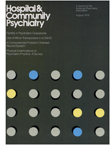Patterns of Utilization of a Neuropsychiatric Assessment Unit
Abstract
During a one-year period an inpatient psychiatric ward specializing in the evaluation of neuropsychiatric disorders admitted 306 patients for neurodiagnostic services and 119 general psychiatric patients for brief treatment. About half the neurodiagnostic patients were referred by sources not affiliated with the unit, and about a quarter came from outside the immediate area, indicating that a variety of community agencies relied on the unit as a referral facility. In nearly 60 per cent of the cases evaluated, suspected medical or neurologic abnormality was confirmed and the probable etiology determined, while in only a small percentage was a proviously unsuspected abnormality detected; this combination of outcomes suggests that most referrals were appropriate and that the unit's main function was to clarify etiologic relationships and design treatment plans.
Access content
To read the fulltext, please use one of the options below to sign in or purchase access.- Personal login
- Institutional Login
- Sign in via OpenAthens
- Register for access
-
Please login/register if you wish to pair your device and check access availability.
Not a subscriber?
PsychiatryOnline subscription options offer access to the DSM-5 library, books, journals, CME, and patient resources. This all-in-one virtual library provides psychiatrists and mental health professionals with key resources for diagnosis, treatment, research, and professional development.
Need more help? PsychiatryOnline Customer Service may be reached by emailing [email protected] or by calling 800-368-5777 (in the U.S.) or 703-907-7322 (outside the U.S.).



